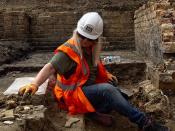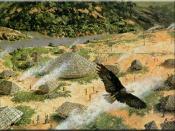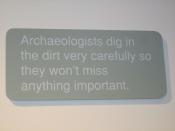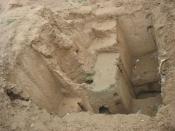Archeology When many people hear the term "archeology"àor perhaps think of what it actually is, most of the time one person comes to mind"æ (PICTURE OF INDIANA JONES) You guessed it! Many people often refer to Harrison Ford's character "Indiana Jones"àand his exciting three movie epic. While some archeologists surely go on various adventures, most of the excitement evolves around the discovery of artifacts or remnants of societies of old. Each discovery serves as a clue in which the archeologist joins together each piece with the hope of being able to see the picture as a whole. However, searching for these pieces may not come from dangerous expeditions like "ÃÂIndiana Jones"àdepicts, but may come in the form of time consuming digs that may seem to be mundane and in reality will look like this"æ We should probably get started with an explanation of what archeology is.
Archeology is a science which carefully studies how people lived in the past by looking at the objects left behind. Archeologists are not fortune hunters who travel to exotic places in search of buried treasure. In fact, archeologists do not keep any of their findings because they care not for the monetary value. Their findings are sources of information that they can use to help them learn how people behaved in the past.
The objects that archeologists find are called artifacts, and when many artifacts are gathered, the archeologist can learn how the different groups of people lived in an area, and even how long they lived there.
When they collect these artifacts, they keep the items together from each area in which they were collected so they can correctly learn about these people. And because all people throughout history have made artifacts and left them behind, so an archeologists work can never done! The area where an archeologist looks for his artifacts is called a site. A site is any place where people have lived or rested for any period of time and left something behind. Sites can be very big with many artifacts, or very small with only a few artifacts. An archeologist knows where to find a site because they know all people liked to live in certain places. There are three things that archeologists know about all people: they need food, water, and shelter. Therefore, archeologists know to look near streams, in caves, and in areas of good ground. They do this because they know people could use the streams as a water source, caves for shelter, and areas of good ground for planting and hunting.
Some artifacts last for a long time. But unfortunately some things do not last as long. For example, carved stones will probably last longest whereas things like shells, bones, wooden items, or food will decay easily. This is because nature preserves things differently. Archeologists know this, and also must understand preservation when they look at artifacts.
There is not one single study of archeology, but rather a few components that make up archeology as a whole. These are: Historic Archeology "ÃÂ the study of archeological sites that date to recent historic times. Some historic archeological sites include house sites (like foundations and cellars), farm sites, manufacturing sites, military sites, historic trash piles (yes even garbage!) and church sites.
Prehistoric Archeology "ÃÂ the study of people who lived before written records. Some prehistoric archeological sites include camps, villages, more trash piles, rock carvings, and pathways.
Urban Archeology "ÃÂ is the study of cities and towns. Some sites include old houses, stores, schools, churches, and old roadways.
Underwater Archeology "ÃÂ is the study of sites which are underwater or along shorelines. Underwater sites may include shipwrecks, bridges, and roads. Some historic and prehistoric sites could be found underwater too! KEY TERMS The following are some key terms that archeologists use. Once you learn them and understand them, you will surely be on your way! Culture "ÃÂ all the things that describe a group of people.
Survey "ÃÂ when an archeologist looks for a site.
Excavation "ÃÂ scientific way of digging a site.
Research design "ÃÂ a series of questions that archeologists ask about the people who lived in the area when choosing a site.
Some could be: 1. Who lived at the site? 2. When did they live at the site? 3. How long did they live there? 4. Are the people from this site from other sites in the area, or are they completely different? 5. When and why did these people leave this site.
Test Pit "ÃÂ a small hole dug with a shovel to find more artifacts, to examine the soils at the site, to find more information about how big the site is and if any buried layers of artifacts are present.
Test Units "ÃÂ the large squares the dig site is divided into. Each square is given a special number.
Field Notes "ÃÂ notes taken by the archeologists do they do not forget anything about their findings. Field notes will tell other what has been found and where it was located.
Classifying "ÃÂ archeologists classify artifacts to help keep order so they can make sense out of them all. Once all the artifacts have been classified, they are described, drawn, and sometimes photographed. Archeologist do all this in order to place the items with the proper culture and within their time period.
Catalog "ÃÂ a list of all artifacts from the site. The catalog will tell the four "W's"ÃÂ: What the artifact is? Where the artifact was found? When the artifact was found? Who found the artifact? Archeologist's Interpretation "ÃÂ when the archeologist is finished looking for artifacts, next they come to a conclusion about the area where they were digging. Next they will write a book or an article about the site telling the story to other archeologists and the public. It is by sharing information that we learn more about the different cultures being studied as well as learning about ourselves!




